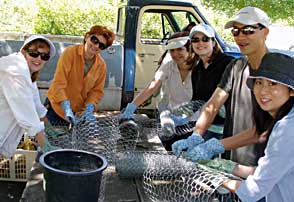Additional Strategies for Success
On the first day of class, explain why the college values learning communities and what educational goals they serve.
Even with good advising and prior experience, students may not understand how learning communities are different from stand-alone courses. Students trust the approach and value the integration more when they understand that both/all instructors are committed to a powerful integrated learning experience.
Explain Learning Community theory in class and in the syllabus.
Students appreciate learning about interdisciplinary, collaborative study goals. Even students who have previously enrolled in a learning community may not understand that they are defined by integrated, active learning and are based on student-to-student, teacher-to-teacher, and student-to-teacher interactions. The emphasis on co-creation of knowledge, active learning, and a search for interdisciplinary links will be challenging for students whose prior experience is only with lecture. Explaining this early helps student learning and attitudes. Sharing this role between faculty reinforces the integrative nature of learning communities.
Explain in class and in the syllabus how your particular learning community will operate.
Students need to hear and read what they want to know: whether time is needed to cover basic discipline-specific work before interdisciplinary connections are explored; to what extent you combined grades and shared assignments and why; how assignments connect to course and learning community objectives; how you coordinate roles and responsibilities. Since each team determines what works best for them, it is critical to communicate to students the how and why of your learning community structure.
Review learning community goals.
By mid-quarter students have forgotten day one. Even though the workload might be better spaced than for stand-alone courses, students often experience learning communities as a single class with massive requirements. You might find it helpful at mid-quarter (or more frequently, if necessary) to review course goals, the "rhythms" of learning communities, ambiguity about concepts, any perceived "chaos" of active learning or collaborative projects, etc.
Connect the courses. Explain connections.
If course assignments do not connect, students will know that, whatever we claim, the learning community is "bogus." Ensure that course work directly relates to the objectives of both courses. Students may need help to understand connections you want them to explore. Periodic checks through CATs or classroom discussions and faculty collaboration on projects and presentations help students feel that both instructors value the connections and the students’ learning.
Collaborate, collaborate, collaborate.
Students really appreciate the chance to hear diverse viewpoints explained and explored and to observe faculty modeling flexibility, close collaboration, communication and respect for each other. They resent the absence or perceived absence of communication and any sense that collaboration is haphazard, i.e., too late or at the expense of classroom time. Collaborate early and lots, especially in weekly out of class planning sessions. If you confer with each other in class, communicate to students how this strategy connects to their learning.
Adapted from Cerritos College Faculty Handbook


